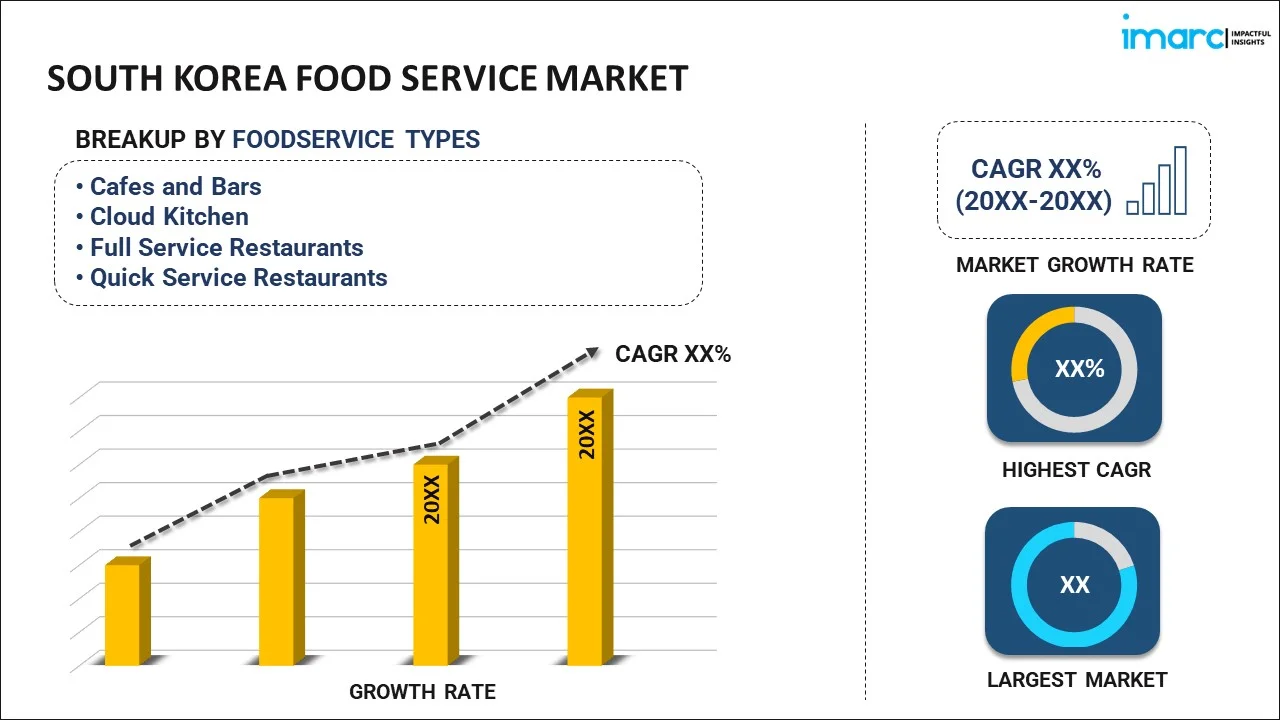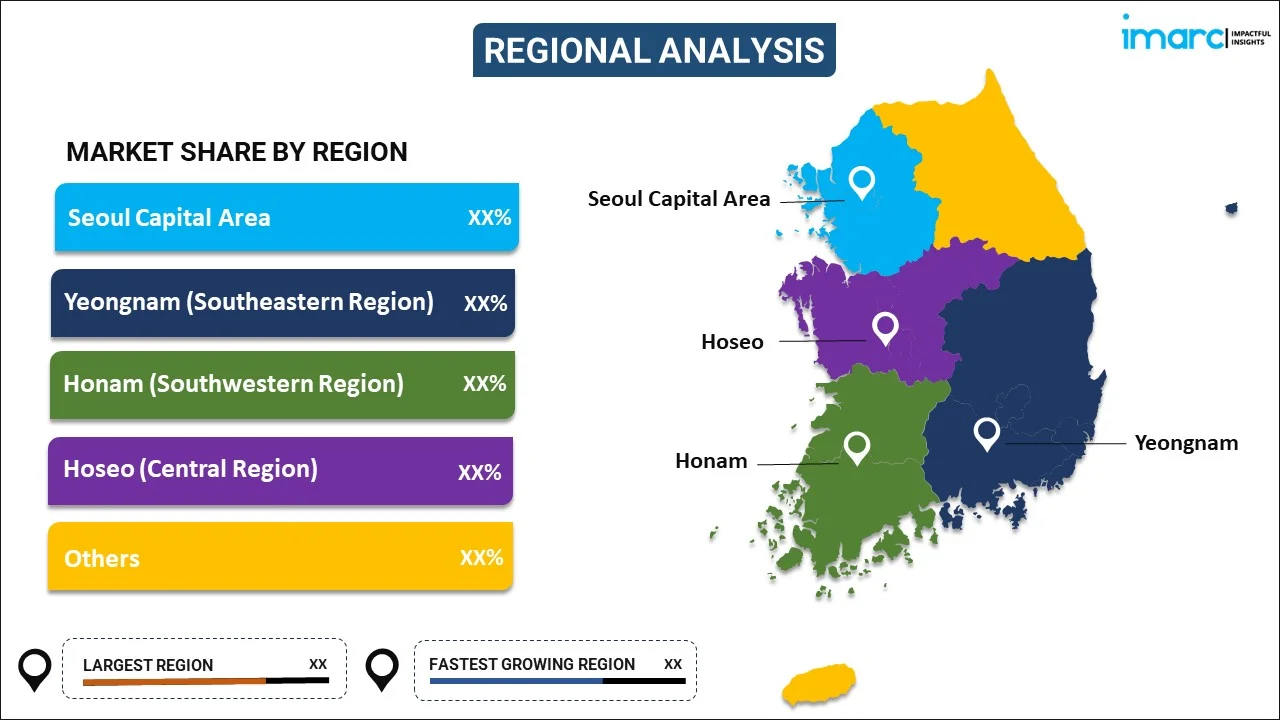
South Korea Food Service Market Report by Foodservice Type (Cafes and Bars, Cloud Kitchen, Full Service Restaurants, Quick Service Restaurants), Outlet (Chained Outlets, Independent Outlets), Location (Leisure, Lodging, Retail, Standalone, Travel), and Region 2025-2033
Market Overview:
South Korea food service market size is projected to exhibit a growth rate (CAGR) of 17.8% during 2025-2033. The increasing advances in technology that can enhance operational efficiency, reduce costs, and improve the overall customer experience, are driving the market.
|
Report Attribute
|
Key Statistics
|
|---|---|
|
Base Year
|
2024 |
|
Forecast Years
|
2025-2033
|
|
Historical Years
|
2019-2024
|
| Market Growth Rate (2025-2033) | 17.8% |
Food service is a dynamic and integral aspect of the hospitality industry, encompassing a wide range of establishments that provide meals and beverages to customers. This sector plays a crucial role in fulfilling the diverse culinary preferences of individuals, offering a spectrum of dining experiences from fast food joints to fine-dining restaurants. Efficient food service involves various components, including menu planning, food preparation, presentation, and customer service. The industry has evolved with changing consumer trends, embracing innovations such as online ordering, food delivery, and sustainable practices. Successful food service establishments prioritize quality ingredients, culinary expertise, and excellent customer interactions to create memorable dining moments. Whether in restaurants, cafeterias, catering services, or food trucks, the food service sector is characterized by its adaptability and commitment to meeting the evolving demands of a diverse and discerning clientele. From casual eateries to gourmet establishments, food service is a vibrant and ever-evolving field at the intersection of gastronomy and customer satisfaction.
South Korea Food Service Market Trends:
The food service market in South Korea is witnessing robust growth driven by various factors. Firstly, the increasing regional population and urbanization have led to a surge in demand for convenient and quick dining options. Additionally, changing consumer lifestyles and preferences, coupled with a rising awareness of diverse cuisines, are fueling the growth of the market. Moreover, technological advancements, such as online food delivery platforms and digital ordering systems, have revolutionized the way consumers access and enjoy food services, further propelling the industry forward. Furthermore, the growing focus on health and wellness is prompting a shift towards healthier menu options, driving innovation in the sector. Importantly, the accelerated adoption of contactless and delivery services can shape new norms in the food service industry, thereby augmenting the market growth. In conclusion, a combination of demographic trends, technological innovations, and changing consumer behaviors are key drivers steering the dynamic evolution of the food service market in South Korea.
South Korea Food Service Market Segmentation:
IMARC Group provides an analysis of the key trends in each segment of the market, along with forecasts at the country level for 2025-2033. Our report has categorized the market based on foodservice type, outlet, and location.
Foodservice Type Insights:

- Cafes and Bars
- Bars and Pubs
- Cafes
- Juice/Smoothie/Desserts Bars
- Specialist Coffee and Tea Shops
- Cloud Kitchen
- Full Service Restaurants
- Asian
- European
- Latin American
- Middle Eastern
- North American
- Others
- Quick Service Restaurants
- Bakeries
- Burger
- Ice Cream
- Meat-based Cuisines
- Pizza
- Others
The report has provided a detailed breakup and analysis of the market based on the foodservice type. This includes cafes and bars (bars and pubs, cafes, juice/smoothie/desserts bars, and specialist coffee and tea shops), cloud kitchen, full service restaurants (asian, european, latin american, middle eastern, north american, and others), and quick service restaurants (bakeries, burger, ice cream, meat-based cuisines, pizza, and others).
Outlet Insights:
- Chained Outlets
- Independent Outlets
A detailed breakup and analysis of the market based on the outlet have also been provided in the report. This includes chained outlets and independent outlets.
Location Insights:
- Leisure
- Lodging
- Retail
- Standalone
- Travel
The report has provided a detailed breakup and analysis of the market based on the location. This includes leisure, lodging, retail, standalone, and travel.
Regional Insights:

- Seoul Capital Area
- Yeongnam (Southeastern Region)
- Honam (Southwestern Region)
- Hoseo (Central Region)
- Others
The report has also provided a comprehensive analysis of all the major regional markets, which include Seoul Capital Area, Yeongnam (Southeastern Region), Honam (Southwestern Region), Hoseo (Central Region) and Others.
Competitive Landscape:
The market research report has also provided a comprehensive analysis of the competitive landscape in the market. Competitive analysis such as market structure, key player positioning, top winning strategies, competitive dashboard, and company evaluation quadrant has been covered in the report. Also, detailed profiles of all major companies have been provided. Some of the key players include:
- CJ Foodville Corporation (CJ Group)
- Domino’s Pizza Inc.
- Kyochon F&B Co. Ltd.
- McDonald’s Corporation
- Mom’s Touch
- Yum! Brands Inc.
(Please note that this is only a partial list of the key players, and the complete list is provided in the report.)
South Korea Food Service Market Report Coverage:
| Report Features | Details |
|---|---|
| Base Year of the Analysis | 2024 |
| Historical Period | 2019-2024 |
| Forecast Period | 2025-2033 |
| Units | Million USD |
| Scope of the Report | Exploration of Historical and Forecast Trends, Industry Catalysts and Challenges, Segment-Wise Historical and Predictive Market Assessment:
|
| Foodservice Types Covered |
|
| Outlets Covered | Chained Outlets, Independent Outlets |
| Locations Covered | Leisure, Lodging, Retail, Standalone, Travel |
| Regions Covered | Seoul Capital Area, Yeongnam (Southeastern Region), Honam (Southwestern Region), Hoseo (Central Region), Others |
| Companies Covered | CJ Foodville Corporation (CJ Group), Domino’s Pizza Inc., Kyochon F&B Co. Ltd., McDonald’s Corporation, Mom’s Touch, Yum! Brands Inc., etc. |
| Customization Scope | 10% Free Customization |
| Post-Sale Analyst Support | 10-12 Weeks |
| Delivery Format | PDF and Excel through Email (We can also provide the editable version of the report in PPT/Word format on special request) |
Key Questions Answered in This Report:
- How has the South Korea food service market performed so far and how will it perform in the coming years?
- What has been the impact of COVID-19 on the South Korea food service market?
- What is the breakup of the South Korea food service market on the basis of foodservice type?
- What is the breakup of the South Korea food service market on the basis of outlet?
- What is the breakup of the South Korea food service market on the basis of location?
- What are the various stages in the value chain of the South Korea food service market?
- What are the key driving factors and challenges in the South Korea food service?
- What is the structure of the South Korea food service market and who are the key players?
- What is the degree of competition in the South Korea food service market?
Key Benefits for Stakeholders:
- IMARC’s industry report offers a comprehensive quantitative analysis of various market segments, historical and current market trends, market forecasts, and dynamics of the South Korea food service market from 2019-2033.
- The research report provides the latest information on the market drivers, challenges, and opportunities in the South Korea food service market.
- Porter's five forces analysis assist stakeholders in assessing the impact of new entrants, competitive rivalry, supplier power, buyer power, and the threat of substitution. It helps stakeholders to analyze the level of competition within the South Korea food service industry and its attractiveness.
- Competitive landscape allows stakeholders to understand their competitive environment and provides an insight into the current positions of key players in the market.
Need more help?
- Speak to our experienced analysts for insights on the current market scenarios.
- Include additional segments and countries to customize the report as per your requirement.
- Gain an unparalleled competitive advantage in your domain by understanding how to utilize the report and positively impacting your operations and revenue.
- For further assistance, please connect with our analysts.
 Inquire Before Buying
Inquire Before Buying
 Speak to an Analyst
Speak to an Analyst
 Request Brochure
Request Brochure
 Request Customization
Request Customization




.webp)




.webp)












